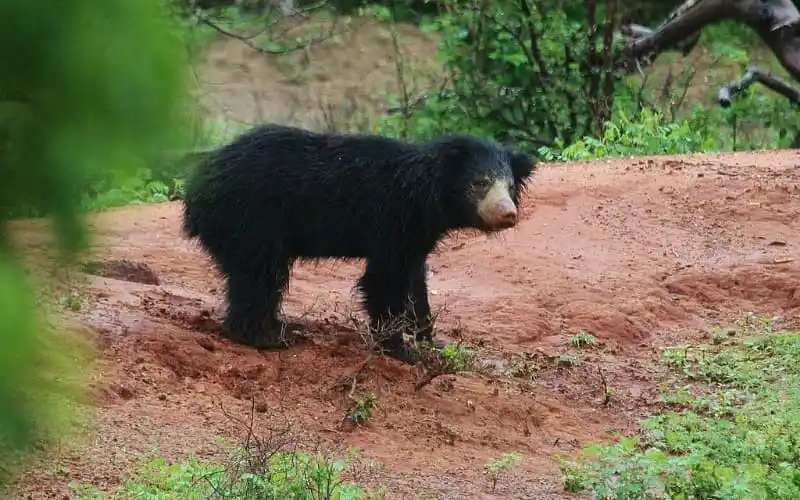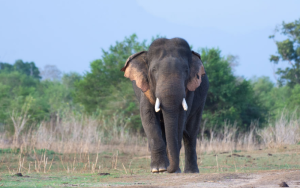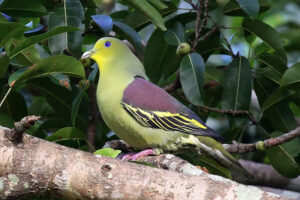About Sri Lankan Sloth Bear
Sri Lankan Sloth Bear! Some may be terrified by the mere mention of the word, but many are unaware that this magnificent creature is on the verge of extinction in Sri Lanka, with its numbers having been drastically reduced, its habitats having been decimated, and the hand of man having been firmly turned against him in a state of abject fear.
Many men from the jungle have told me that they would prefer to face an elephant’s charge because they believe they have a chance of escaping if they do. In contrast, there is none when it comes to the sloth bear (Melursus ursinus) and its terrifying “close quarters charge.” When you combine that with the distinct possibility of being blinded, disfigured, or losing a limb or two, the reasons for fear and animosity toward this creature become abundantly obvious. Most people in forest communities, however, are terrified of becoming “the living dead”: blinded, incapable of caring for themselves, and completely dependent on others until death finally takes over, which is viewed as a welcome relief from a lifetime of suffering.
Using the phrase “wonderful creature” to describe an animal with such a reputation would appear to be a significant distortion of the truth. However, it is the truth.
Many people are unaware that the sloth bear is on the verge of extinction in Sri Lanka. Man’s hand has firmly turned against the creature in a state of abject fear. Most people in forest communities are terrified of becoming “the living dead”: blinded, incapable of caring for themselves
Gentle Creatures of the Wild
The sloth bear is a “gentle” creature who prefers to live his life in peace and quiet, uninhibited by humans. He spends his days scrounging for worms, beetles, and termites, breaking open hard termite mounds with his steel-hard claws, or climbing the Ceylon ironwood trees (Manilkara hexandra), also known as Palu, in search of its beloved berries.
Once the “inner bear” is satisfied, he would retire to his den or to a convenient location, such as a hollow log or a crevice between boulders, where he would contentedly suck his paws while making a humming noise, perhaps falling into a deep snoring sleep, until the next morning. Several villagers I know have strayed to within a few feet of the creature before being alerted to its presence by the snoring. This is especially true when the creature has a belly full of Palu fruit.
Such close calls, fortunately for both parties, resulted in the respective parties “running for the hills at breakneck speed” in opposite directions as a result of their close encounters.
It is this very same habit of falling asleep for long periods of time or becoming completely absorbed in sucking up termites with great pleasure that leads to tragedy, both for the sloth bear and for the unfortunate human who unwittingly comes into contact with the animal. When the sloth bear is startled, it either flees in the opposite direction it is facing or charges the “attacker” with unrestrained ferocity.
Few creatures can match the bravery of a mother-sloth bear who will fight to the death to protect her young cubs. Former assistant director of Sri Lanka’s Department of Wildlife Conservation, Percy De Alwis, recounted how a honey gatherer was charged by a very determined and aggressive sloth bear. De Alwis died in 2013. An accurate billhook to the head by the man proved to be effective in deterring the sloth bear’s advances. During this time, the sloth bear staggered and fell, then picked itself up and ran into the jungle on shaky feet, screaming; meanwhile, in the opposite direction, the man dropped his gourd full of honey and his billhook and ran as fast as he could.
When the man returned to the same location the next day to retrieve his belongings, he was surprised to discover that they had been left exactly where they had fallen. Fortunately, a low noise from a partially rotten log nearby piqued his attention, and upon investigating with extreme caution, expecting a charge at any moment, he was confronted with an extremely pathetic sight: there, within the hollow log, lay a bear, its head caked with dried blood, while two tiny balls of black fur were trying to suckle from their dead mother, crying the entire time because she was not responding. The sloth bear had dragged itself back to the cubs it had risked its life to protect in its final moments.
The cubs, on the other hand, were more fortunate. They were given over to De Alwis, who raised them with love and care throughout their lives. Visitors to Sri Lanka’s northern Wilpattu National Park were fascinated and entertained by the two apes, who were given the names Kalu and Zimbo. They also experienced a few frightening moments as a result of their presence.
The sloth bear is a “gentle” creature who prefers to live his life in peace and quiet. He spends his days scrounging for worms, beetles, and termites. When the sloth bears is startled, it either flees or charges the “attacker”. A honey gatherer was charged by a very determined and aggressive sloth bear. An accurate billhook to the head by the man proved to be effective in deterring the animal. Visitors to Sri Lanka’s northern Wilpattu National Park were fascinated and entertained by the two apes
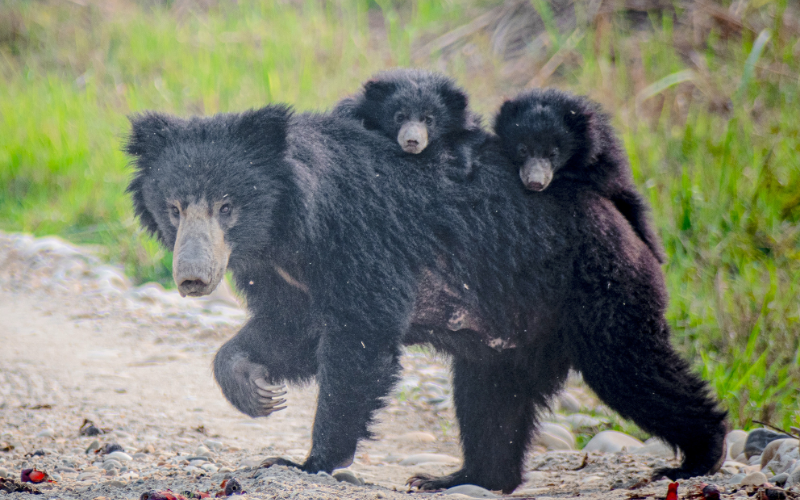
No Predators
M.U. Inoratus, a distinct subspecies of the sloth bear found only in Sri Lanka, is not preyed upon here; however, tigers in India are known to prey on sloth bears, with some tigers becoming habitual bear hunters. Several tigers are said to have developed a specific kill procedure that involves striking the bear with a disabling injury and then retreating to a safe distance while the unfortunate bear exhausts itself trying to flee the situation. In order to finish its meal without endangering itself, after it has been weakened, the tiger delivers the fatal blow. In this video, these tigers appear to be well aware of the fierce defensive tactics used by sloth bears that can result in them being injured and rendered unable to fight. Humans are doomed when they suffer such injuries. The same is said to be true for leopards in India, but I am unaware of any actual kills in Sri Lanka, despite the fact that there have been numerous reported encounters.
A minority indigenous group in Sri Lanka called the Veddas developed their own methods of avoiding sloth bears, which they encounter on a regular basis while hunting and gathering food. When they approach likely sloth bear habitats, they tap tree trunks and boulders with their axes and yell to warn the animals of their presence, giving the animal enough time to retreat without feeling threatened, which would otherwise result in a precipitate charge from the bears if they were not careful.
Many conflicts arose as a result of the extinction of these true children of the jungle and the arrival of the urbanized colonist, who was unfamiliar with the ways of the jungle and its denizens. Because sloth bears were considered a feared and despised enemy by the Vedas, the creature was given an extremely abusive name to reflect this. Many people believe that mantras or sacred utterances cause a sloth bear to flee in fear, but the truth is that it is more the vociferous, aggressive utterances, the bold front, and the sound of the dreaded human voice that causes it to flee, giving it an avenue of escape, that does the trick. It is impossible to get out if you don’t try.
It will be upon the man in an instant, rising on hind legs to rake the great claws across his face, wiping away half of his face and possibly an eye in one stroke, baring the skull in the process, biting, scratching, and clawing, all the while accompanied by demonic roars. All of a sudden, the attack is over, and the animal flees screaming away from the scene of mischief, making loud wails and roars as if it were he who had been attacked, leaving behind a man who has been horribly disfigured, mutilated, and broken, but who is more often than not barely alive.
Tigers in India are known to prey on sloth bears, a distinct subspecies of the sloth bear found only in Sri Lanka. Several tigers are said to have developed a specific kill procedure that involves striking the bear with a disabling injury and then retreating while the bear exhausts itself trying to flee. Sloth bears were considered a feared and despised enemy by the Vedas. Many people believe that mantras or sacred utterances cause a sloth bear to flee in fear. The truth is that it is more the aggressive front, and the sound of the dreaded human voice that causes it to flee
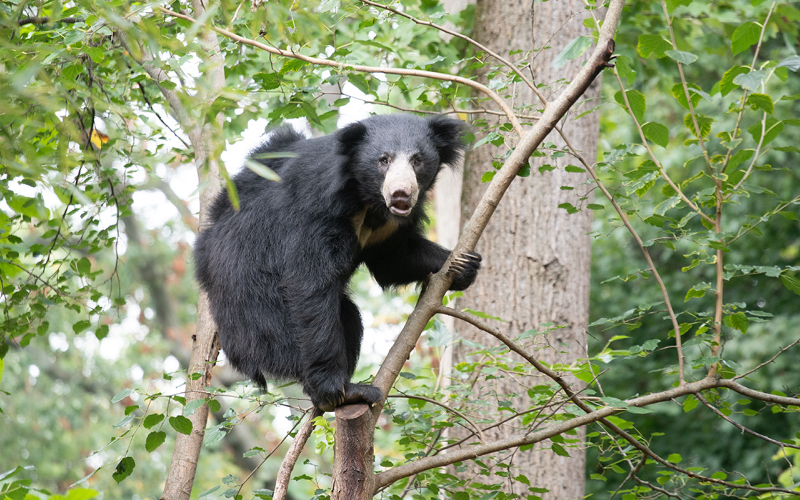
The Devil Incarnates
The sloth bear has also been treated unfairly in folklore and legend, as it is widely considered to be a monster. While other animals have been associated with benign deities and spirits, the sloth bear has not been so fortunate.
Various animals, including the elephant, peacock, and cobra, are associated with Ganesh, the Hindu god of wisdom with an elephant-headed head, Lord Skanda, and the mythical Nagas, among many others, are regarded with benign regard as creatures of the Pansiya Panas Jathaka, or the 550 reincarnations of Siddhartha, in his quest for Buddhahood. The sloth bear, on the other hand, is associated with “the evil lord of the burial spaces,” the dreaded Mahasona, who walks the jungle paths at night with a gaping bear’s head fixed “back to front,” bringing pestilence, disease, and death to the terror-stricken villagers in the remote corners of the world.
Furthermore, there is a legend about two giant warriors from the fabled King Dutugemunu, Gotaimbara and Ritigala Jayasena, who came into conflict and fought for several hours, both of whom were exponents of martial arts, and who fought for the honor of their king. Gotaimbara finally jumped into the air and delivered a flying kick that shattered Jayasena’s head, causing his lifeless body to fall to the floor. Lord Saturn was passing through that area when he came across the wife of Jayasena, who was weeping dejectedly by the dead body of her lord, and he was moved to tears by her plight.
In the course of his astrological calculations, he discovered that if the first head found in the auspicious direction was cut off and fixed to the dead body, Jayasena could be brought back to life. Before the auspicious hour passed, it was necessary to complete this task. Lord Saturn hurried in the direction prescribed, but he came across no human heads, and time was running out when he came across a sloth bear, whose head he cut off with a sharp instrument. He rushed back to the scene, with the clock ticking down to the final seconds, and fixed the head onto the body, bringing it back to life. However, in his haste, he had placed the head on the wrong side of the body.
After regaining consciousness, Jayasena, realizing the hideous transformation he had undergone, fled with bloodcurdling screams to hide in cemeteries, away from humans, devouring the corpses that had been brought there, and seeking vengeance against humans for the rest of his life. With this background, it’s no surprise that the sloth bear is regarded by superstitious people as “the devil incarnate.”
The sloth bear is associated with “the evil lord of the burial spaces,” the dreaded Mahasona. The mythical Nagas are regarded with benign regard as creatures of the Pansiya Panas Jathaka, or the 550 reincarnations of Siddhartha. Saturn’s astrological calculations discovered that the first head found in the right direction could bring Jayasena back to life. However, in his haste, he placed the head on the wrong side of the body. The sloth bear is regarded by superstitious people as “the devil incarnate

Understanding The Behavior
According to legends and folklore, this “gentle creature of the forests” is demonized and vilified. True to their nature, sloth bears are wonderful and caring parents who lavish a great deal of affection on their offspring.
On the edge of a paddy field from which the harvest had been harvested several weeks earlier, I spent an idyllic moonlit night 12 meters (40 feet) above the ground in a hut built among entwined branches of three enormous trees. It was a magical night that will remain etched in my memory forever. The presence of a herd of elephants in this remote corner of Sri Lanka’s North Central province, attracted by the new growth springing from the stubble of paddy, as well as deer and a slew of other visitors, was reported in this remote corner of the province.
The full moon shone brightly on the small field and the surrounding jungles, transforming them into ever-changing shadows of fantasy. I had climbed into the hut alone, armed with nothing more than a torch and a billhook for defense, and I had done so to take pleasure in the bright light of the full moon that transformed the field and the surrounding jungles into ever-changing shadows of fantasy, to observe the denizens of the surrounding forests emerge from time to time engaged in their chores of existence.
I sat at the edge of the platform, my feet dangling high above the ground below, the roof only a few feet above my head, preventing me from entering or exiting the platform, and I watched the creatures come and go as they passed by on the other side. In the middle of the night, a cry from the jungle was answered by another, and soon after, three blobs of black moved onto the threshing floor, which was about 23 meters (75 feet) away, and completely unaware of my presence in the area.
To watch the mother sloth bear rummaging around, pausing now and then, often with one forepaw in the air, to look around for the two cubs who were engaged in a game of their own, providing hours of amusement. The children would be called back in a low tone if they got too far away from mom. Cubs would chase after their mother and attempt to climb onto her back, while the mother waited patiently for them to be done with their games. While the female’s concern was obvious, so was the affection with which she moved her prey to one side so that she could continue her feeding session on the other side.
They had a great time running around, wrestling, and cuffing each other in a mock fight before it was time to leave, with the mother carefully shepherding the two young cubs, who were still bent on playing, toward the bushes. After a while, they grew tired of their games and decided to take a ride on the mother bear’s back, disappearing into the darkness.
The sloth bear is a strange creature, capable of eliciting a wide range of human emotions in its victims. There are those who regard them as fellow beings who treat them with dignity and respect, who coexist peacefully with them, who have a deep affection for the often-misunderstood animal, and there are those who are committed to the conservation of the species as well as its habitats.
At the historic Magul Maha Vihara in eastern Sri Lanka, one gloomy monsoon afternoon, I was led by the hand to an ancient rock shelter, where I was shown a sloth bear sleeping on the fine warm dust on the floor of a rocky crevice around 27 meters (89 feet) away from the lone human caretaker of the ruins. This bear was said to be “habitual” in the area and was said to be completely unaffected by human presence.
Other visitors and staff became quite taken with a huge, fine young male who frequented the vicinity of a water hole in northern Wilpattu and became quite a talking point. According to the then-warden M.M.D. Perera, it became ill all of a sudden. The body was discovered floating on the water the following day. The tracker Karunaratne wept over his death, as Perera recalls. This was evidence of the affection felt by a grown man in the jungle, for whom death was an ever-present certainty that he had to deal with every day, as Perera explains.
Others have described an encounter with a bear as a life-changing event, not only because of the disfigurement, disability, and blindness they have suffered but also because it was the catalyst for an extreme shift in attitude and an outpouring of compassion. D.J.G. Hennessy, the intrepid jungle man, and hunter of rogue elephants shot at a family of bears over a water hole in the middle of the night and followed the blood trail, recording the agonizing cries he heard in the distance. “The harsh scream of the peafowl, emanating from the leafless trees that they adore, heralded the arrival of the Dawn.
It was a hundred yards away on a game track that I discovered her lying in a pool of blood with her tongue hanging out of her mouth. While we were approaching, a cub leaped to his stumpy little hind legs and snorted defiance at us before scampering into the jungle, crying piteously for the one who, in his small world, was everything, and ran off into the distance. “It is for this reason that I became a wild animal protector.”
Faced with the tide of urbanization and the extinction of their forest habitat, sloth bears are retreating at a breakneck pace, accompanied by their forest habitat. If they are extinct, the world will be a poorer place because of their demise.
The sloth bear is a strange creature, capable of eliciting a wide range of human emotions in its victims. There are those who regard them as fellow beings who treat them with dignity and respect. And there are those committed to the conservation of the species as well as its habitats. D.J.G. Hennessy shot at a family of bears over a water hole in the middle of the night and followed the blood trail, recording the agonizing cries he heard in the distance. “It is for this reason that I became a wild animal protector,” he says.

Sri Lankan Sloth Bear Facts
They have a cream-colored muzzle, large prehensile lips, and a long tongue. Their paws are equipped with well-developed hook-like claws that enable them to climb trees and dig for termites. The head and body grow up to 6 feet in length and can weigh up to 140kg for a male and 95 kg for a female.
Where We Can Find Sri Lankan Sloth Bear?
The Sri Lankan Sloth Bear can be found in various habitats across Sri Lanka, including dry forests, scrublands, and grasslands. Some of the national parks where the sloth bear can be found include Yala National Park, Wilpattu National Park, and Horton Plains National Park. However, as with many wildlife species, the Sri Lankan Sloth Bear is endangered and its population is under threat due to habitat loss and hunting. Therefore, it is important to practice responsible tourism when visiting these areas and to support conservation efforts to ensure the protection of the sloth bear and its habitat. A guided tour with a reputable wildlife tour operator, such as Ceylon Wild Tours, can offer a safe and sustainable way to experience the beauty of the Sri Lankan Sloth Bear and other wildlife species in their natural habitats.
Conclusion
In conclusion, the Sri Lankan Sloth Bear is a unique and fascinating species that can be found in various habitats across Sri Lanka. While these bears are known for their shaggy coats and distinctive markings, they are also under threat due to habitat loss and hunting. By supporting responsible tourism and conservation efforts, we can help protect the Sri Lankan Sloth Bear and other wildlife species in their natural habitats. A guided tour with a reputable wildlife tour operator, such as Ceylon Wild Tours, offers a safe and sustainable way to experience the beauty of the Sri Lankan Sloth Bear and learn about its behavior and conservation needs. Let’s work together to ensure the survival of this amazing animal for generations to come. Book your Sri Lankan Sloth Bear tour with Ceylon Wild Tours or Share Traveller today and experience the wonder of Sri Lanka’s wildlife.

